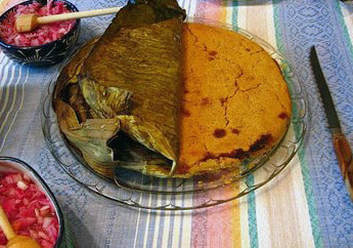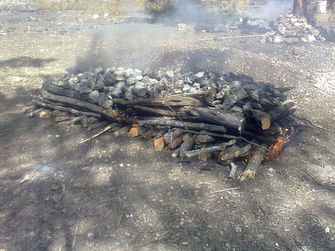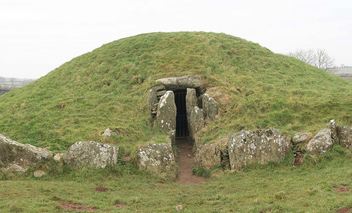|
Today a lot of articles and radio features will appear, reminding us that Halloween as we know it originated as Samhain in Celtic paganism, that jack-o-lanterns were originally carved turnips, and that people originally wore masks to avoid harmful spirits while welcoming those of their ancestors on this night when the space between the worlds of living and dead is thin.
But I'd like to suggest to you that tonight and tomorrow represent more than inconsequential historical trivia. And that they relate to more than Ireland! When traditions persist for more than 5,000 years, we might want to take them seriously. Read on for just a few examples of similar celebrations at the same time, and a few thoughts on what we might take from the awareness that welcoming the dead and recognizing the thin place between worlds at this moment of the year has seemed significant for a long, long time. Hanal Pixán
More than 41 indigenous groups in Mexico hold celebrations for the dead from October 31-November 2. Although the country's Día de Muertos represents a fusion of ancient beliefs and rituals with those brought by Christian Spaniards, hints of the oldest ways can be seen in the particularities of a region's celebration. The Yucatan observes Mayan customs more than 3,000 years old during Hanal Pixán (literally, "food for the souls" in the Mayan language). These traditions include marking a path for deceased relatives to find their way home, setting places at the table for them, and the holiday's signature dish, mucbipollo, literally "chicken" (Spanish) "that has been buried" (Mayan).
Traditionally, the dish--similar to a large tamale--made with corn and chicken (or sometimes pork) is wrapped in banana leaves and then cooked in a pit in the family's yard, with embers heating limestone at the bottom and more wood placed on top of the wrapped bundles. In the Mayan creation story, humans were made of corn. Here we have the corn (human) descending into the pit of the earth, being literally buried, and then re-emerging ... as food for the souls. Dziady
Dziady, or "grandfathers," is the Polish word for ancient Slavic celebrations "strongly linked to a conviction that during seasonal changes, especially autumn at the turn of October and November, the spirits of the dead returned to the world of the living from the afterworld, making it possible to interact with one’s ancestors." Customs included offering ancestors food, wearing masks, making ceremonial fires, and celebrating in the graveyard, as well as pouring sacrificial blood.
Samhain
Let’s not leave out the Celts! But maybe not even the Celts, because some mounds like those above are 4,500 to 5,000 years old, predating when the Celts arrived in Ireland. At any rate, in addition to the various aspects of Samhain you may have heard cited as antecedents for Halloween, there are also mounds, or passage tombs, around Ireland with a connection to this holiday.
Whereas the Mayan corn being lowered into the pit probably creates a grave-like image for you, it would be hard to see the openings in the images above as anything other than vulvas. Walking into these mounds, you are not being buried in the Earth, but fucking Her. These mounds have inner passageways decorated with astrological and symbolic motifs. They were often surrounded by vast ritual complexes and standing stones, some that would likely rival Stonehenge if they remained intact today. One feature of these mounds is a carefully calibrated opening that allows the sun to pierce the inner chamber exactly twice per year – – for some, like the Mound of the Hostages, those two days were Samhain, and its spring counterpart, Beltane. Imagine the sun ritually penetrating the Earth's dark opening on this High Holy Day . . . yeah, you get it. Mokosz's Holiday
Mokosz, or Mokosha, or Mokusa, is an ancient Slavic goddess worshipped by what today are Russians, Ukranians, Poles, Czechs, and others. Her annual holiday was held from October 25-November 1, right during the time of a seasonal Dziady festival (see above). She is described often as an "Earth Mother" goddess ruling childbirth, but that is a later compression. Our society has been dyadic for so long that it is hard for us to feel our way into Her true nature.
Read about Her a little, and you find that Her name means "damp." She rules weaving, and thus is associated with spiders, Fate, and divination. Go back to the older stories and She is also the Goddess of Sex and Death. Mokosz is the Damp, Sex-Earth Mother of the Irish mounds, beautiful and alluring, fierce and a little scary, definitely bigger than we can understand. Watch the music video above dedicated to Her and you will get the sense of Her better than dry words can convey. (Also notice that it fits perfectly with Halloween.) So what?
So what do we make of this? Well, here are a few things that come to my mind. Maybe you will think of some more (in which case, comment and share)!
We are headed into the dark days of the year. Earlier this month, Jupiter moved into Scorpio for the first time since 2006, where it will reside for the next 13 months. This brings the chance to expand our boundaries even to mythic proportions (Jupiter) in the hidden areas of our lives (Scorpio) -- sex, death, what has been taboo, and our archetypal shadow. Like a good researcher, Scorpio brings to the surface what has been hidden. It facilitates the Plutonic transformation--that great archetypal passage into the shadow, our personal cave. This year, even more than most, we might benefit from embracing the dark. Let me know if I can help you with your journey.
1 Comment
11/17/2019 10:00:11 am
Halloween is my favorite occasion of the year. I think that this is the only time when I can be a kid again. I feel like there are lots of ways that I can relive my youth, but I am not really interested in other events. I feel like I need to go and try out costumes so that I can feel that I am a kid again. I plan on going on as Doctor Strange for this year's Halloween.
Reply
Leave a Reply. |
Joy SalyersCounselor/Coach, Consultant, Folklorist, High Priestess of Where Things Meet and the Places Between Categories
All
|




 RSS Feed
RSS Feed